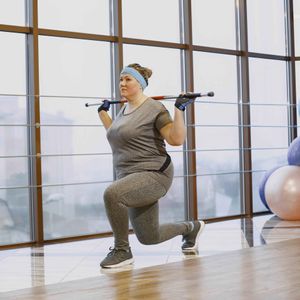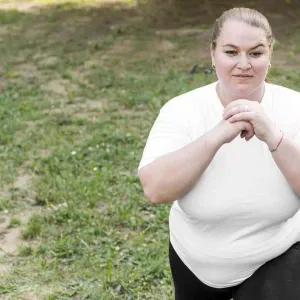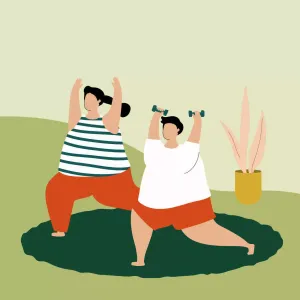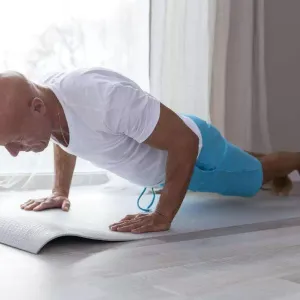

Our Review Process
Our articles undergo extensive medical review by board-certified practitioners to confirm that all factual inferences with respect to medical conditions, symptoms, treatments, and protocols are legitimate, canonical, and adhere to current guidelines and the latest discoveries. Read more.
Our Editorial Team
Shifa Fatima, MSc.
Author
Dr. Apoorva T, MHM.
MEDICAL ADVISOR
Exercise for seniors over 75
The human body is designed not to be sedentary. It is made for ample amounts of exercise along with following a diet. This is not just true in the initial and formative years of life but is also applicable when one grows older, even more during old age. Exercise and nutrition are often considered the two pillars of a healthy lifestyle. Several studies have highlighted the growing need to continue exercising even until a person grows old – and have provided multiple reasons for the same. It is, of course, important to moderate your exercises so that you do not aggravate any health condition especially if you fall under the older category.
Exercise for seniors over 75 can be tricky to conduct but important to maintain. Since physiology changes as a person grows older, physical activity plays a different role in the bodies of an older adult as compared to a younger one. They have different reasons for staying in shape. Even though physical fitness is important at every age, the health perks that people enjoy when they are fit at all stages of life. The advantages are more noticeable when a person grows older and is still healthy and fit. Many doctors also recommend that seniors should remain as active as possible, without the risk or need to overexert. Exercise has been linked to multiple physical and mental health benefits:
- Exercise leads to independence – Studies at Harvard Medical School show that seniors who exercise are less likely to be dependent on others. It promotes a kind of self-esteem that helps a senior person be more confident in their ability to walk, bathe, cook, eat, use the washroom, etc. It is one of the most recommended ways to enhance self-reliance.
- Exercise improves balance – The older population is at a much bigger risk of falling to alarming statistics. Every 11 seconds, one older adult is known to be taken to the emergency room and admitted for an injury that occurred due to a fall. Even though each fall is different and results in different consequences, regular exercise reduces the risk of falling by 23%
- Exercise can instill energy – Yes, exercise can help you gain more energy and make you feel active. This is due to the release of endorphins – these are important neurotransmitters that are linked to the lowering of pain and are important for self-esteem. Endorphins can also help to combat the negative stress hormones and can promote healthy sleep which can also result in more energy.
- Exercise helps prevent and manage diseases – Many deadly and chronic illnesses like – heart disease, osteoporosis, diabetes, blood pressure, etc can be prevented with regular exercise. Adopting a more active lifestyle can help delay the onset of these conditions and sometimes even prevent them. If you are already dealing with these medical conditions, the symptoms can be managed with the help of exercise.
- Exercise improves brain function – With the declining cognitive functioning as a person grows older, exercise for seniors over 70 can also help perform remarkable developments regarding brain performance. A healthy body can also lead to a healthy mind and cognitive health. Studies have shown that regular exercise can reduce the risk of development of Alzheimer’s disease by approximately 50%
Table of Contents
What counts as light exercises
Older adults are encouraged to perform some exercises throughout the day, even if they are light and not tiring. Minimal levels of activity can help benefit the overall health of a person significantly. Lighter levels of exercise can lead to productivity and motivation to perform much bigger workout routines by spending more time on them as well. Depending on the age and level of fitness and mobility, the exercise for an old age person should be determined according to the approval given by the doctors. The activity level and intensity should be appropriate to your medical conditions and the amount of work you already do.
If the person is not very active, has joint pain, does not move around much, and has limited strength, exercise can help improve all of these issues slowly. However, for that, it would be important to start the workout regime slowly to not aggravate issues and then expand to tougher tasks. Examples of light activity would be:
- Making a cup of tea or getting water for oneself
- Moving around the home
- Walking at your own pace in the house or garden
- Cleaning and dusting – ensure that you are not bending too much in case of hip and knee issues
- Vacuuming, if possible
- Making the bed
- Folding clothes (this activity can be a great exercise for the arms)
Light activities can help you feel more independent and give you the confidence to be able to do other activities as well. From making yourself a cup of tea to helping prepare a light snack in the kitchen, one can gradually increase the level of difficulty of their tasks. Lighter workout regimes can also be a great way of community building and socializing as you can join laughter clubs, walking groups, etc. Another thing that an older person can engage in would be walking to the garden nearby and sitting with their friends. This may not be counted as exercise per se, but can be a great way to make a person feel belong and can boost confidence.
What counts as moderate-intensity exercises
Whether you have started with lighter routines and moved on to tougher ones or have the fitness and motivation level to directly begin with moderately intense workout routines, you can think about doing these. It would be vital to get your fitness level tested before you start exercises for seniors over 80 as you would want to know what would be appropriate for you to do in terms of working out. Activities that count as moderate intensity are often the ones that end up increasing your heart rate and making you breathe faster. You will also notice your body temperature rise when you perform these activities. A good way to measure the intensity would be if you can talk normally but not sing.
Some tasks that you can perform that would count as moderate-intensity would be:
- Walking – brisk walking can be beneficial and fun
- Water aerobics
- Cycling – stationary bike or outdoors based on your comfort level
- Dancing activities
- Hiking (not a steep or high-altitude mountain, but just a hill or an incline)
Moderate exercises can help the body and the mind as they are the ones that release endorphins in the brain. These are good stress-busters and you will notice yourself in a seemingly good and joyous mood once the activity is over. Such exercises help motivate the person to do more and better. You can also engage in these tasks in a group to add a social element to your workout routine.
What counts as vigorous-intensity exercises
Vigorous-intensity exercises may differ for different people, this is more applicable in the older population. Since the older population are more susceptible to comorbidities owing to their declining mental and physical age, they are more likely to experience pains and fatigue faster. This is why it would be important to consult your doctor before you perform any activity that can lead to potential problems. It would be advisable if you conducted these activities under the guidance of a trainer so that they could assess your level of fitness and tell you when to stop or how much to do.
The best exercises for seniors over 70 would be enough for about 50-60 minutes if they are of vigorous intensity. These activities will make you breathe hard and fast and you may not be able to speak much without pausing for a breath. Another way to achieve this would be by using moderately intense activities but increasing your effort.
Some examples of exercises that are vigorous would be:
- Running
- Aerobics
- Swimming
- Speed riding bikes, or cycling on an incline
- Hiking uphill
- Zumba
Not every older adult will be able to perform all of these, and they should not. Check with your trainers before engaging in any of these for the best results.

Best exercises for seniors over 75
Knowing where to begin and what to do would be a good first step to start exercising. If you have not worked out in a while, it can get particularly tough to get back on the saddle. Your body might not be accustomed to the movement and there can be an increase in pain and soreness in the body, therefore, before you launch yourself into a full-blown exercise regime, check for activities that you are more comfortable doing and make sure that you are healthy enough for exercises based on your current fitness level.
Here are some good exercises for seniors over 80:
1) Water aerobics
In recent years, water aerobics are becoming popular among people of all ages, but particularly for seniors. It is ideal for people living with joint pains and arthritis. The buoyancy of the water puts less stress on the joints and the natural resistance of the water can help gain strength. This is, therefore, a great routine to begin with as it can increase strength, flexibility, and balance. Aqua jogging, flutter kicking, leg lifts, etc are great exercises to engage in
2) Chair yoga
Yoga is beneficial in any form. Chair yoga is a low-impact exercise that improves muscle strength, balance, mobility, and flexibility, and can add other benefits. It adds less stress to muscles and joints and is also helpful in bettering the symptoms of depression. Overhead stretch, seated twist, seated cow stretch, etc are possible forms of yoga that can be done.
3) Resistance band workout
These are user-friendly and accessible for beginners. This is increasing in popularity among seniors as they are not expensive and can be done at home. These workouts can strengthen your core and improve posture and mobility. Leg press, lateral raise, bicep curl, and band pull apart, are just some of the poses that you can do with these.
4) Walking
If you are just beginning and do not want to risk it with any activity that can even be moderately straining, walking can be a great way to start. It is advised as a minimal activity for a healthy lifestyle and can lower the risk of heart problems, stroke, diabetes, etc. Walking in the park, through a trail, inside your building, etc is also good enough
5) Dumbbell strength training
Strength training is known to reduce symptoms of diabetes, osteoporosis, back pain, depression, etc and can also help in weight management. It contributes to better metabolism and sugar control. Perform these exercises with proper precautions. You can strengthen isolated muscle groups and improve balance and flexibility. Some workouts could be – tricep extension, bicep curl, front raises, etc
Bottomline
Any kind of exercise for seniors over 70 will be helpful if they are performed with caution. It is recommended to not live a sedentary lifestyle and work out for at least 30 minutes every day. You also need to understand what exercises to avoid at your age so that there is a lesser risk of injury and pain. In case you are engaging in vigorous exercises, make sure that it is done under the guidance of a professional. The multiple benefits associated with exercise even for people of older ages have made it almost a mandatory activity for them.
FAQs
Can you get in shape at 75?
Yes, it is possible to get in shape even at the age of 75. It may take some time for the body to get used to changes and work out, however, with a proper diet regime and regular exercise, it will be possible to slowly lose weight, strengthen the body and joints, and gain more confidence to do the tasks that you are supposed to perform even in daily life.
How fast should a 75-year-old walk?
Doctors suggest that brisk walking – walking slightly faster than the regular pace – can be a good enough speed for a 75-year-old. This is taking 80-100 steps per minute. This would also depend on the person and their factors. It is advised to follow your own patterns and not generalize your workout routine with others, especially at an older age.
How many steps should a 75-year-old walk per day?
Reaching your daily step count even as an older person will help in many ways. Adults over 70 should aim to walk anywhere between 3000-10,000 steps in a day depending on their current level of activity and health. If you feel overly tired, do not overexert, and take it slow.
What exercises should seniors not do?
Many popular mainstream workouts may not be good for the senior population. These exercises would be well-suited for younger adults so that they can bulk up and shed weight. Squats with dumbbells, bench presses, long-distance running, crunches, deadlifts, HIIT, etc should not be done by seniors extensively or recommended to do under supervision.
Disclaimer
This website's content is provided only for educational reasons and is not meant to be a replacement for professional medical advice. Due to individual differences, the reader should contact their physician to decide whether the material is applicable to their case.








